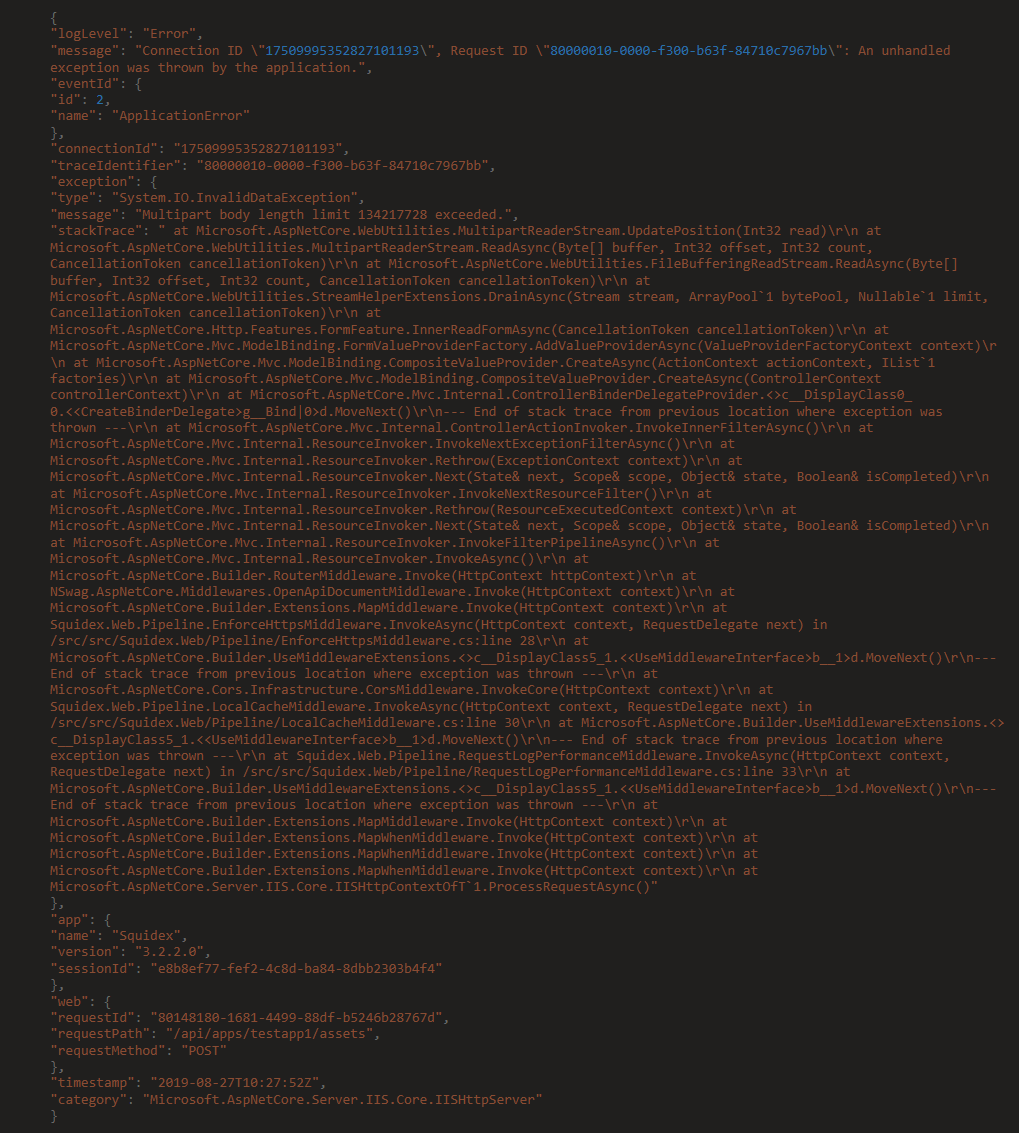I have…
- [ ] Checked the logs and have provided uploaded a log file and provided a link because I found something suspicious there.
“logLevel”: “Error”,
“message”: “Connection ID “17509995352827101193”, Request ID “80000010-0000-f300-b63f-84710c7967bb”: An unhandled exception was thrown by the application.”,
“eventId”: {
“id”: 2,
“name”: “ApplicationError”
},
“connectionId”: “17509995352827101193”,
“traceIdentifier”: “80000010-0000-f300-b63f-84710c7967bb”,
“exception”: {
“type”: “System.IO.InvalidDataException”,
“message”: “Multipart body length limit 134217728 exceeded.”,
“stackTrace”: " at Microsoft.AspNetCore.WebUtilities.MultipartReaderStream.UpdatePosition(Int32 read)\r\n at Microsoft.AspNetCore.WebUtilities.MultipartReaderStream.ReadAsync(Byte[] buffer, Int32 offset, Int32 count, CancellationToken cancellationToken)\r\n at Microsoft.AspNetCore.WebUtilities.FileBufferingReadStream.ReadAsync(Byte[] buffer, Int32 offset, Int32 count, CancellationToken cancellationToken)\r\n at Microsoft.AspNetCore.WebUtilities.StreamHelperExtensions.DrainAsync(Stream stream, ArrayPool
1 bytePool, Nullable1 limit, CancellationToken cancellationToken)\r\n at Microsoft.AspNetCore.Http.Features.FormFeature.InnerReadFormAsync(CancellationToken cancellationToken)\r\n at Microsoft.AspNetCore.Mvc.ModelBinding.FormValueProviderFactory.AddValueProviderAsync(ValueProviderFactoryContext context)\r\n at Microsoft.AspNetCore.Mvc.ModelBinding.CompositeValueProvider.CreateAsync(ActionContext actionContext, IList1 factories)\r\n at Microsoft.AspNetCore.Mvc.ModelBinding.CompositeValueProvider.CreateAsync(ControllerContext controllerContext)\r\n at Microsoft.AspNetCore.Mvc.Internal.ControllerBinderDelegateProvider.<>c__DisplayClass0_0.<<CreateBinderDelegate>g__Bind|0>d.MoveNext()\r\n--- End of stack trace from previous location where exception was thrown ---\r\n at Microsoft.AspNetCore.Mvc.Internal.ControllerActionInvoker.InvokeInnerFilterAsync()\r\n at Microsoft.AspNetCore.Mvc.Internal.ResourceInvoker.InvokeNextExceptionFilterAsync()\r\n at Microsoft.AspNetCore.Mvc.Internal.ResourceInvoker.Rethrow(ExceptionContext context)\r\n at Microsoft.AspNetCore.Mvc.Internal.ResourceInvoker.Next(State& next, Scope& scope, Object& state, Boolean& isCompleted)\r\n at Microsoft.AspNetCore.Mvc.Internal.ResourceInvoker.InvokeNextResourceFilter()\r\n at Microsoft.AspNetCore.Mvc.Internal.ResourceInvoker.Rethrow(ResourceExecutedContext context)\r\n at Microsoft.AspNetCore.Mvc.Internal.ResourceInvoker.Next(State& next, Scope& scope, Object& state, Boolean& isCompleted)\r\n at Microsoft.AspNetCore.Mvc.Internal.ResourceInvoker.InvokeFilterPipelineAsync()\r\n at Microsoft.AspNetCore.Mvc.Internal.ResourceInvoker.InvokeAsync()\r\n at Microsoft.AspNetCore.Builder.RouterMiddleware.Invoke(HttpContext httpContext)\r\n at NSwag.AspNetCore.Middlewares.OpenApiDocumentMiddleware.Invoke(HttpContext context)\r\n at Microsoft.AspNetCore.Builder.Extensions.MapMiddleware.Invoke(HttpContext context)\r\n at Squidex.Web.Pipeline.EnforceHttpsMiddleware.InvokeAsync(HttpContext context, RequestDelegate next) in /src/src/Squidex.Web/Pipeline/EnforceHttpsMiddleware.cs:line 28\r\n at Microsoft.AspNetCore.Builder.UseMiddlewareExtensions.<>c__DisplayClass5_1.<<UseMiddlewareInterface>b__1>d.MoveNext()\r\n--- End of stack trace from previous location where exception was thrown ---\r\n at Microsoft.AspNetCore.Cors.Infrastructure.CorsMiddleware.InvokeCore(HttpContext context)\r\n at Squidex.Web.Pipeline.LocalCacheMiddleware.InvokeAsync(HttpContext context, RequestDelegate next) in /src/src/Squidex.Web/Pipeline/LocalCacheMiddleware.cs:line 30\r\n at Microsoft.AspNetCore.Builder.UseMiddlewareExtensions.<>c__DisplayClass5_1.<<UseMiddlewareInterface>b__1>d.MoveNext()\r\n--- End of stack trace from previous location where exception was thrown ---\r\n at Squidex.Web.Pipeline.RequestLogPerformanceMiddleware.InvokeAsync(HttpContext context, RequestDelegate next) in /src/src/Squidex.Web/Pipeline/RequestLogPerformanceMiddleware.cs:line 33\r\n at Microsoft.AspNetCore.Builder.UseMiddlewareExtensions.<>c__DisplayClass5_1.<<UseMiddlewareInterface>b__1>d.MoveNext()\r\n--- End of stack trace from previous location where exception was thrown ---\r\n at Microsoft.AspNetCore.Builder.Extensions.MapMiddleware.Invoke(HttpContext context)\r\n at Microsoft.AspNetCore.Builder.Extensions.MapWhenMiddleware.Invoke(HttpContext context)\r\n at Microsoft.AspNetCore.Builder.Extensions.MapWhenMiddleware.Invoke(HttpContext context)\r\n at Microsoft.AspNetCore.Builder.Extensions.MapWhenMiddleware.Invoke(HttpContext context)\r\n at Microsoft.AspNetCore.Server.IIS.Core.IISHttpContextOfT1.ProcessRequestAsync()"},
“app”: {
“name”: “Squidex”,
“version”: “3.2.2.0”,
“sessionId”: “e8b8ef77-fef2-4c8d-ba84-8dbb2303b4f4”
},
“web”: {
“requestId”: “80148180-1681-4499-88df-b5246b28767d”,
“requestPath”: “/api/apps/testapp1/assets”,
“requestMethod”: “POST”
},
“timestamp”: “2019-08-27T10:27:52Z”,
“category”: “Microsoft.AspNetCore.Server.IIS.Core.IISHttpServer”
}
I’m submitting a…
- [ ] Regression (a behavior that stopped working in a new release)
- [ x] Bug report
- [ ] Performance issue
- [ ] Documentation issue or request
Current behavior
When uploading a file larger than 130MB, the upload fails.
Expected behavior
1GB file uploads should work
Minimal reproduction of the problem
Set IIS and Squidex file size limits to the max, attempt to upload a file
Environment
- [ ] Self hosted with docker
- [ x] Self hosted with IIS
- [ ] Self hosted with other version
- [ ] Cloud version
Version: [34]
Browser:
- [ x] Chrome (desktop)
- [ ] Chrome (Android)
- [ ] Chrome (iOS)
- [ ] Firefox
- [ ] Safari (desktop)
- [ ] Safari (iOS)
- [ ] IE
- [ ] Edge
Others:
